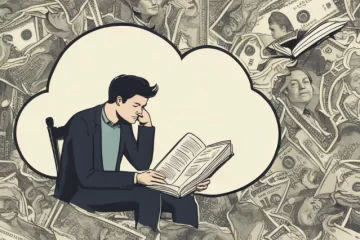Unlocking the Secrets of Effective Decision Making in Meltdown

In the complex world of decision making, where outcomes often hang in the balance between success and failure, two acclaimed authors, Chris Clearfield and András Tilcsik, have teamed up to shed light on the intricacies of our choices. In their groundbreaking book, “Meltdown,” they explore the hidden factors that often lead to catastrophic failures and offer invaluable insights into how we can navigate the challenges to make better decisions. From the boardrooms to the operating rooms, their research unveils a new perspective on decision making that promises to revolutionize the way we approach critical choices. Join us as we delve into the captivating world of decision making through the lens of “Meltdown,” a must-read for anyone seeking to understand the art and science behind successful decision making.
What is Decision Making
Decision making is the process of selecting the best course of action from among various alternatives in order to achieve a desired outcome. It involves identifying and evaluating different options, considering the possible consequences and risks associated with each option, and ultimately making a choice that is deemed to be the most rational, practical, and effective. Decision making can take place in various contexts, such as personal life, professional settings, or in organizations, and it often involves a combination of logical reasoning, intuitive judgment, past experiences, and information analysis. Efficient and effective decision making is crucial for problem-solving, planning, and achieving goals.
Why is Decision Making Important to Us?
Decision making is important to us for several reasons:
1. Problem-solving: Decision making helps us identify and analyze problems, evaluate various solutions, and choose the most appropriate one. It allows us to address challenges and find effective solutions.
2. Efficiency and productivity: By making sound decisions, we avoid wasting time and resources on ineffective or unnecessary actions. It helps us streamline our work and achieve tasks more efficiently, leading to increased productivity.
3. Personal and professional growth: Decision making allows us to take responsibility for our actions and choices. It helps us learn from our mistakes, make better choices in the future, and grow as individuals. In a professional setting, effective decision making can lead to career advancement and success.
4. Achieving goals: Every decision we make has the potential to move us closer or further away from our goals. By making informed and well-thought-out decisions, we increase our chances of achieving the outcomes we desire, both personally and professionally.
5. Confidence and empowerment: When we make decisions with clarity and confidence, we feel empowered and in control of our lives. It boosts our self-esteem and allows us to trust our abilities to navigate through challenges and uncertainties.
6. Collaboration and teamwork: Decision making is often a collaborative process, especially in group settings or organizations. Effective decision making fosters teamwork, as it involves evaluating different perspectives, discussing options, and reaching a consensus. It helps build stronger relationships and improves overall collaboration.
7. Managing risks: Decision making involves evaluating potential risks and uncertainties associated with different choices. By making informed decisions, we can minimize risks and make calculated moves, ensuring that our actions have better outcomes and reducing the chances of negative consequences.
Overall, decision making plays a crucial role in our personal and professional lives. It shapes our actions, helps us achieve our goals, and contributes to our growth and success.
Unlocking Decision Making from Meltdown

Meltdown Introduction
Meltdown: Why Our Systems Fail and What We Can Do About It” written by Chris Clearfield and András Tilcsik explores the factors that lead to major system failures in various industries, such as finance, technology, healthcare, and transportation. The book delves into the underlying causes of these breakdowns, emphasizing the interconnectedness of complex systems and the unintended consequences that arise from them.
Clearfield and Tilcsik break down the book into three key sections: the interaction between complexity and failure, the role of diversity in systems, and strategies for managing and preventing meltdowns.
In the first section, the authors explore how modern systems have become increasingly complex, relying on intricate networks and interdependencies. They highlight the vulnerabilities and failure points inherent in such systems. The book emphasizes that individual failures are rarely the root cause of large-scale meltdowns, but rather the unforeseen cascade effects that arise due to the complexity of interactions.
The second section focuses on the importance of diversity in systems. The authors argue that a lack of diversity, whether it be in perspectives, expertise, or decision-making, can lead to blind spots and groupthink. They demonstrate the significance of diverse teams and inclusive decision-making processes in mitigating risks and preventing major failures.
In the final section, Clearfield and Tilcsik provide practical strategies for managing and preventing meltdowns. They discuss the role of prediction, early warning signs, and decision-making processes, emphasizing the need for adaptive systems that can quickly respond to emerging threats. The authors also highlight the value of learning from failures and implementing feedback loops to improve system functionality.
Overall, “Meltdown” offers a thought-provoking analysis of systemic failures and provides insights on how organizations can better navigate the complexities of modern systems. It urges readers to approach failures as opportunities for learning and improvement while advocating for more mindful decision-making processes and diverse teams.
Decision Making Methods
In the book “Meltdown: Why Our Systems Fail and What We Can Do About It” by Chris Clearfield and András Tilcsik, several decision-making methods are discussed. Some of them include:
1. Red teaming: This method involves setting up a team of individuals who are independent of the project or system being assessed. Their role is to critically analyze and challenge assumptions, identify potential weaknesses, and propose alternative viewpoints or strategies.
2. Pre-mortems: This method involves imagining that a project or system has failed in the future and then working backward to identify the reasons for the failure. By considering different scenarios that could lead to failure, decision-makers can take proactive measures to prevent them from happening.
3. Monte Carlo simulations: This method involves using statistical techniques to model a system or project by incorporating various random variables and inputs. By running multiple simulations, decision-makers can better understand the potential outcomes, risks, and uncertainties associated with their decisions.
4. Root cause analysis: This method aims to identify the underlying reasons or causes of problems or failures within a system. It involves going beyond surface-level analysis and exploring the deeper systemic issues or errors that led to the specific failure.
5. Adaptive decision-making: This method emphasizes flexibility and the ability to rapidly adjust decisions based on feedback and changing circumstances. Instead of sticking rigidly to a predefined plan, decision-makers continuously assess the situation, gather information, and adapt their strategies accordingly.
These are just a few decision-making methods mentioned in the book “Meltdown.” The authors emphasize the importance of understanding complex systems, cognitive biases, and organizational dynamics in making effective decisions.
Meltdown Quotes
Meltdown quotes as follows:
1.Understanding the risks and benefits associated with nuclear energy is crucial for informed decision-making.
2.From Fukushima to Chernobyl, learn from past mistakes to ensure a safer and more sustainable future.
3.The consequences of a nuclear disaster can have far-reaching effects on the environment, health, and society.
4.Dive into the history, politics, and science behind nuclear power, shedding light on its complex implications.
5.Explore the fascinating world of nuclear energy, its potential dangers, and the importance of safety measures.

More Books About Meltdown by Chris Clearfield, András Tilcsik
1. Designing Your Life” by Bill Burnett, Dave Evans
In “Designing Your Life,” Burnett and Evans introduce the concept of applying design thinking principles to create a fulfilling and successful life. This book guides readers through a systematic process of building a personalized roadmap towards achieving their professional and personal goals, emphasizing adaptability, resilience, and innovative problem-solving techniques.
2. Leading” by Alex Ferguson
Drawing on his highly successful career as the manager of Manchester United, Alex Ferguson shares invaluable leadership insights in “Leading.” Highlighting the importance of team dynamics, discipline, adaptability, and effective communication, Ferguson’s book offers practical advice for individuals aspiring to lead and manage organizations, making it an excellent companion to “Meltdown.”
3. Smart Choices” by John S. Hammond, Ralph L. Keeney, Howard Raiffa
“Smart Choices” delves into the art and science of decision-making by presenting a structured framework for making informed choices, especially in complex and uncertain situations. This book offers compelling tools and strategies to evaluate risks, weigh potential outcomes, and mitigate unforeseen consequences – essential skills to prevent and navigate through meltdowns.
4. Thinking, Fast and Slow” by Daniel Kahneman
In “Thinking, Fast and Slow,” Nobel laureate Daniel Kahneman explores the intricate workings of our minds and the biases that often lead to flawed decision-making. Kahneman presents cutting-edge research on cognitive psychology, shedding light on how our thinking can be improved to prevent costly mistakes and lessen the probability of meltdowns.
5. The Black Swan: The Impact of the Highly Improbable” by Nassim Nicholas Taleb
The Black Swan” challenges the conventional notion that rare and unpredictable events, known as Black Swans, are outliers that can be disregarded. Taleb highlights their profound impact and offers insights into how we can better anticipate and respond to unexpected events. This thought-provoking book offers valuable perspectives on recognizing vulnerabilities and designing robust systems resilient to meltdowns.
By exploring these five books alongside “Meltdown” by Chris Clearfield and András Tilcsik, readers can gain a comprehensive understanding of decision-making, crisis management, and resilience, providing a well-rounded perspective on preventing and handling meltdowns in various domains.



7 Comments
Moneyball: Revolutionizing Crisis Management · 12/14/2023 at 13:09
[…] Crisis management refers to the process of handling and mitigating a crisis situation that can potentially harm an organization’s reputation, operations, or stakeholders. It involves a strategic and coordinated approach to respond to the crisis, manage its impact, and prevent any further damage. […]
Exploring the Corrosive Impact of Finances on Politics in Dark Money - singleread.com · 12/22/2023 at 00:00
[…] illuminate different aspects of the forces shaping our world. From examining political funding and crisis management to exploring international relations and media manipulation, these works provide valuable insights […]
Crafting a Winning Business Strategy with Innovation and Entrepreneurship - singleread.com · 01/08/2024 at 10:12
[…] 5. Alignment and focus: A well-defined business strategy ensures that all employees are aligned and working towards the same goals and objectives. It provides clarity on priorities, increases focus, and helps create a cohesive organizational culture. […]
Boosting Team Performance: Insights from John Whitmore's Coaching for Management - singleread.com · 01/09/2024 at 00:02
[…] and teams. In “Let My People Go Surfing,” he emphasizes the importance of creating an organizational culture that values personal growth and encourages autonomy. This book complements Whitmore’s work by […]
Surviving Crisis with Ben Horowitz: Lessons from 'The Hard Thing About Hard Things' - singleread.com · 01/11/2024 at 00:01
[…] their impact, and establishing protocols to effectively respond to and communicate during crises. Crisis management aims to minimize the damage caused by a crisis, protect the reputation of an individual or […]
Enhancing Management Performance: Lessons from The Checklist Manifesto - singleread.com · 01/25/2024 at 00:05
[…] Organizational culture and morale: Management shapes the organizational culture by establishing norms, values, and […]
The Age of Gold: Unveiling the American Dream's Glittering Era - singleread.com · 02/01/2024 at 00:01
[…] 3. “The Panic of 1907: Lessons Learned from the Market’s Perfect Storm” by Robert F. Bruner and Sean D. Carr: Examining one of the most significant financial crises in American history, this book analyzes the causes, consequences, and lessons learned from the Panic of 1907, shedding light on economic fluctuations and the role of government in crisis management. […]